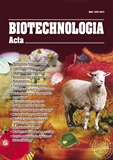SSN 2410-7751 (Print)
ISSN 2410-776X (Online)

Biotechnologia Acta Т. 16, No. 2 , 2023
P.30-31, Bibliography 3, Engl.
UDC: 577.2
https://10.15407/biotech16.02.030
Full text: (PDF, in English)
TRANSMISSION ELECTRON MICROSCOPY FOR THE DIRECT ANALYSIS OF FIBRIN CLOT STRUCTURE
Y.P. Kucheriavyi, I.D. Panas
Palladin Institute of biochemistry of the National Academy of Sciences of Ukraine, Kyiv
The aim of our study was to compare the structure of clots formed as a result of thrombin-induced fibrin polymerization in the presence or absence of monoclonal fibrin-specific antibodies fragments as factors that change the clot structure. We concentrated on the final stage of fibrin clot formation at maximal turbidity point for every sample.
Methods. Fibrin polymerization was studied by transmission electron microscopy (TEM) of negatively contrasted samples on H-600 Transmission Electron Microscope (“Hitachi”,Japan); 1% water solution of uranyl acetate (“Merck”, Germany) was used as a negative contrast. For sample preparation, in sterile glass tubes were sequentially added 0.32 mg/mL human fibrinogen, 0.025 M CaCl2 in 0.05 M ammonium formiate buffer (pH 7.9), and a total sample volume was 0.22 mL. The polymerization of fibrin was initiated by the introduction of thrombin at a final concentration of 0.25 NIH/mL. After 180 s, aliquots were taken from the polymerization medium. Each aliquot was diluted to a final fibrinogen concentration of 0.07 mg/mL; 0.01 mL probes of fibrinogen solution were transferred to a carbon lattice, which was treated with a 1% uranyl acetate solution after 2 minutes. Investigations were per-formed using an H-600 electron microscope at 75 kV. Electron microscopic images were obtained at magnification of 20,000 -50,000.
Results. Two monoclonal antibodies fragments were obtained towards the mixture of separated Aα-, Bβ- and γ-chains of fibrinogen. Antibodies fragments that were marked as III-1D and I-4A, had different epitopes within fragment Аα105-206 of D-region of fibrinogen.
It was shown that addition of antibody fragment I-4A lead to formation of abnormal fibrils that were thinner than in the control sample and were organized in the dense network (Figure). Control sample exhibited the thick fibrils with well-structured classically organized network. The difference between control and I-4A samples demonstrated that antibody I-4A disrupted the structure of polymerized fibrin. In the same time the fibrils obtained in the presence of antibody fragment III-1D were closer to the control ones.
Conclusions. TEM is an informative method for the study of the fibrin network formation. Its application allows to estimate the disruption in fi brin formation directly. In a combination with turbidity study and other functional tests TEM can provide important information about molecular mechanisms of clot formation.
Key words: fibrin, TEM, fab, polymerization, fibrils, antibody fragment.
© Palladin Institute of Biochemistry of the National Academy of Sciences of Ukraine, 2023
References
1. Weisel J. W., Nagaswami C. Computer modeling of fibrin polymerization kinetics correlated with
electron microscope and turbidity observations: clot structure and assembly are kinetically controlled.
Biophys J. 1992 Jul;63(1), 111–128. https://doi.org/10.1016/S0006-3495(92)81594-1 PMID:
1420861; PMCID: PMC1262129.
2. Chernysh I. N., Nagaswami C., Weisel J. W. Visualization and identification of the structures formed
during early stages of fibrin polymerization. Blood. 2011 Apr 28;117(17), 4609–4614. https://doi.
org/10.1182/blood-2010-07-297671 Epub 2011 Jan 19. PMID: 21248064; PMCID: PMC3099577.
3. Stohnii Y. M., Sakovich V. V., Chernyshenko V. O., Chernishov V. I., Chernyshenko T. M., Kolesnikova I.,
Kucheriavyi Y. P., Zhernossekov D. D. Fibrinogenolytic activity of protease from the culture fluid of
Pleurotus ostreatus. Journal of Biological Research — Bollettino Della Società Italiana Di Biologia
Sperimentale, 2020, 93(2). https://doi.org/10.4081/jbr.2020.9006

